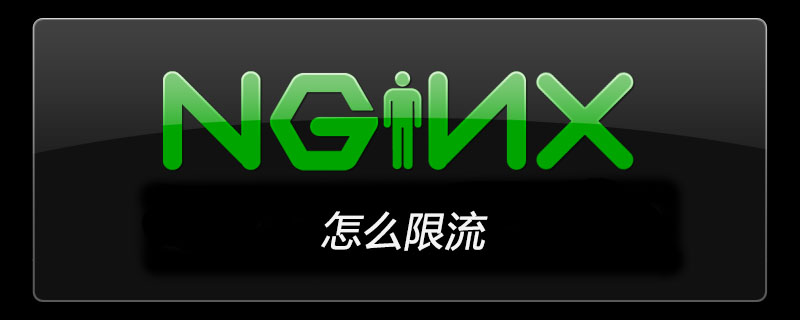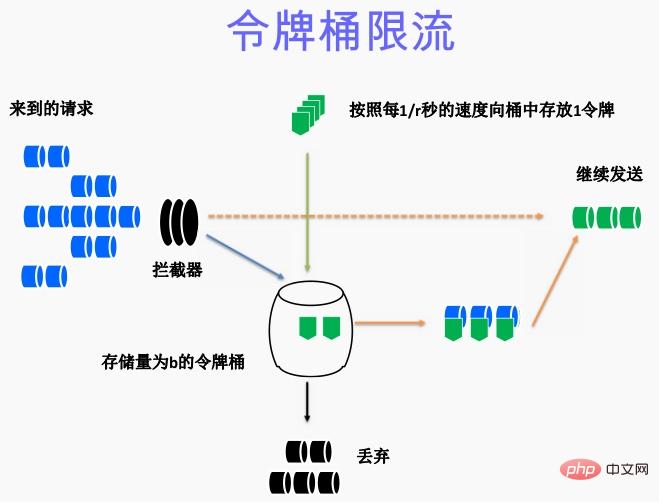How to limit nginx flow
When marketing e-commerce platforms, we often encounter large traffic problems. In addition to traffic diversion processing, we may also need to perform user black and white lists and reputation analysis, and then perform corresponding traffic interception and traffic restriction based on the user's IP reputation weight.

Nginx's own request limiting module ngx_http_limit_req_module and traffic limiting module ngx_stream_limit_conn_module are based on the token bucket algorithm, which can easily control the token rate and customize the current limit. , to achieve basic current limiting control.

The algorithm idea is:
Tokens are generated at a fixed rate and cached in the token bucket;
When the token bucket is full, the excess tokens are discarded;
The request must consume an equal proportion of tokens to be processed;
When there are not enough tokens, the request is processed cache.
Leaky Bucket Algorithm:

The algorithm idea is:
Water (Request ) is poured into the bucket from above and flows out from the bottom of the bucket (processed);
The water that is too late to flow out is stored in the bucket (buffer) and flows out at a fixed rate; when the bucket is full, the water overflows (discarded).
The core of this algorithm is: caching requests, processing them at a uniform speed, and discarding redundant requests directly.
Compared with the leaky bucket algorithm, the difference between the token bucket algorithm is that it not only has a "bucket", but also a queue. This bucket is used to store tokens, and the queue is used to store requests.
In terms of function, the most obvious difference between the leaky bucket and token bucket algorithms is whether to allow burst traffic (burst) processing. The leaky bucket algorithm can forcibly limit the real-time transmission (processing) rate of data. Burst traffic does not undergo additional processing; the token bucket algorithm can limit the average transmission rate of data while allowing a certain degree of burst transmission.
The Nginx speed limit module based on the request rate uses a leaky bucket algorithm, which can forcibly guarantee that the real-time processing speed of requests will not exceed the set threshold.
The official version of Nginx has two modules for limiting IP connections and concurrency:
limit_req_zone is used to limit the number of requests per unit time, that is, rate limit, adopted Leaky bucket algorithm "leaky bucket".
limit_req_conn is used to limit the number of connections at the same time, that is, concurrency limit.
For more Nginx related technical articles, please visit the Nginx usage tutorial column to learn!
The above is the detailed content of How to limit nginx flow. For more information, please follow other related articles on the PHP Chinese website!

Hot AI Tools

Undresser.AI Undress
AI-powered app for creating realistic nude photos

AI Clothes Remover
Online AI tool for removing clothes from photos.

Undress AI Tool
Undress images for free

Clothoff.io
AI clothes remover

Video Face Swap
Swap faces in any video effortlessly with our completely free AI face swap tool!

Hot Article

Hot Tools

Notepad++7.3.1
Easy-to-use and free code editor

SublimeText3 Chinese version
Chinese version, very easy to use

Zend Studio 13.0.1
Powerful PHP integrated development environment

Dreamweaver CS6
Visual web development tools

SublimeText3 Mac version
God-level code editing software (SublimeText3)

Hot Topics
 How to configure nginx in Windows
Apr 14, 2025 pm 12:57 PM
How to configure nginx in Windows
Apr 14, 2025 pm 12:57 PM
How to configure Nginx in Windows? Install Nginx and create a virtual host configuration. Modify the main configuration file and include the virtual host configuration. Start or reload Nginx. Test the configuration and view the website. Selectively enable SSL and configure SSL certificates. Selectively set the firewall to allow port 80 and 443 traffic.
 How to check the name of the docker container
Apr 15, 2025 pm 12:21 PM
How to check the name of the docker container
Apr 15, 2025 pm 12:21 PM
You can query the Docker container name by following the steps: List all containers (docker ps). Filter the container list (using the grep command). Gets the container name (located in the "NAMES" column).
 How to start containers by docker
Apr 15, 2025 pm 12:27 PM
How to start containers by docker
Apr 15, 2025 pm 12:27 PM
Docker container startup steps: Pull the container image: Run "docker pull [mirror name]". Create a container: Use "docker create [options] [mirror name] [commands and parameters]". Start the container: Execute "docker start [Container name or ID]". Check container status: Verify that the container is running with "docker ps".
 How to check whether nginx is started
Apr 14, 2025 pm 01:03 PM
How to check whether nginx is started
Apr 14, 2025 pm 01:03 PM
How to confirm whether Nginx is started: 1. Use the command line: systemctl status nginx (Linux/Unix), netstat -ano | findstr 80 (Windows); 2. Check whether port 80 is open; 3. Check the Nginx startup message in the system log; 4. Use third-party tools, such as Nagios, Zabbix, and Icinga.
 How to check nginx version
Apr 14, 2025 am 11:57 AM
How to check nginx version
Apr 14, 2025 am 11:57 AM
The methods that can query the Nginx version are: use the nginx -v command; view the version directive in the nginx.conf file; open the Nginx error page and view the page title.
 How to create containers for docker
Apr 15, 2025 pm 12:18 PM
How to create containers for docker
Apr 15, 2025 pm 12:18 PM
Create a container in Docker: 1. Pull the image: docker pull [mirror name] 2. Create a container: docker run [Options] [mirror name] [Command] 3. Start the container: docker start [Container name]
 How to configure cloud server domain name in nginx
Apr 14, 2025 pm 12:18 PM
How to configure cloud server domain name in nginx
Apr 14, 2025 pm 12:18 PM
How to configure an Nginx domain name on a cloud server: Create an A record pointing to the public IP address of the cloud server. Add virtual host blocks in the Nginx configuration file, specifying the listening port, domain name, and website root directory. Restart Nginx to apply the changes. Access the domain name test configuration. Other notes: Install the SSL certificate to enable HTTPS, ensure that the firewall allows port 80 traffic, and wait for DNS resolution to take effect.
 How to start nginx server
Apr 14, 2025 pm 12:27 PM
How to start nginx server
Apr 14, 2025 pm 12:27 PM
Starting an Nginx server requires different steps according to different operating systems: Linux/Unix system: Install the Nginx package (for example, using apt-get or yum). Use systemctl to start an Nginx service (for example, sudo systemctl start nginx). Windows system: Download and install Windows binary files. Start Nginx using the nginx.exe executable (for example, nginx.exe -c conf\nginx.conf). No matter which operating system you use, you can access the server IP






